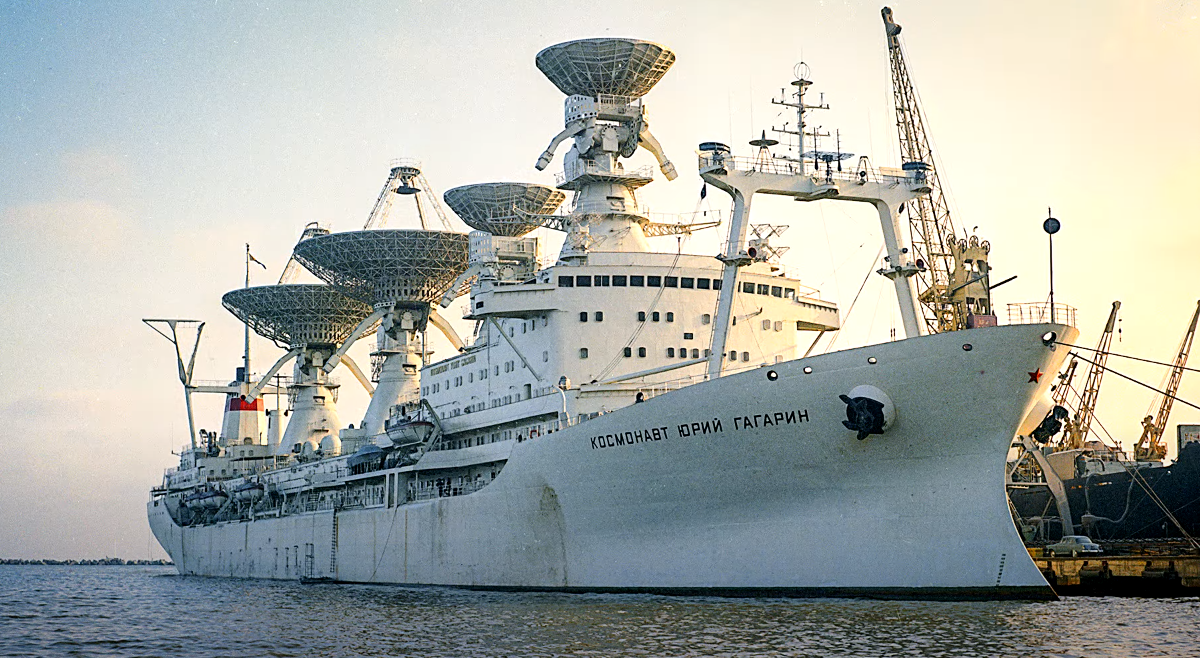The displacement of the British passenger liner, by the way, was 28 thousand tons. It seems that no one has ever made bigger ones, but there are bigger ships in the world.
The palm belongs to warships. For example, the Russian aircraft carrier Admiral Kuznetsov has a displacement of more than 60 tons. By the way, this hulk was laid up in 2017, they promised to modernize and fix it in a few years.
 Russian aircraft carrier Admiral Kuznetsov. Photo: Youtube.com
Russian aircraft carrier Admiral Kuznetsov. Photo: Youtube.comBut today we will not touch on military models, but will talk about a scientific expedition ship, although we used it for other purposes. This is a ship of the space fleet, surpassing the Titanic in displacement by almost two times - 45 thousand tons. The conversation will be about the ship with the proud name "Cosmonaut Yuri Gagarin".
Appearance
The history of the world's largest expeditionary ship began with the fact that it was not connected with the seas and oceans. The end of the 1950s in the USSR was marked by a high interest in space. The USSR and the USA wanted to be the first to conquer the unknown.
The Soviet Union was ahead of the former allies, and now opponents - in 1960, the dogs Belka and Strelka returned safely from space. But the most important thing was ahead. In 1961, Yuri Gagarin became the first person to fly into space and return to Earth.
 And in the USA there was no such ship in those years! Photo: Youtube.com
And in the USA there was no such ship in those years! Photo: Youtube.comWhat's with the fleet? And despite the fact that most of the Earth is covered by oceans, therefore, it is easiest to maintain continuous communication with the “conquerors of the universe” from ships. The ground laboratory is not able to move, but for a ship this is not unusual.
By order of Nikita Sergeevich Khrushchev, the construction of a space fleet began in the USSR. The uniqueness of the project is that all the ships differed in size, and their equipment was at the level of science fiction writers' stories.
The first 5 ships of the Soviet space fleet were built in 1967. To speed up the process, they did not make them from scratch - they took timber trucks.
The flagship of the fleet was the Cosmonaut Yuri Gagarin. Completed construction in 1971. A tanker was used as a base for the expedition vessel.
Features
Even now, "Cosmonaut Yuri Gagarin" is amazing, and this is only when viewing photo / video materials. Unfortunately, this ship has not survived to this day, so it will not be possible to see it in full size.
 A little beat up by life, but still on track. Photo: Youtube.com
A little beat up by life, but still on track. Photo: Youtube.comThe length of the ship was almost 232 meters with a width of 32 meters and a displacement of 45 tons. Full crew - 136 people, plus more than 200 members of the expedition. Externally, the vessel could be identified immediately by the huge antennas, reminiscent of satellite "dishes" from the 90s.
The ship was partially autonomous - it could stay at sea for at least 130 days. And this is if you do not save. This figure could have been many times higher if it were not for restrictions on fuel reserves. It, with such dimensions, was difficult to save.
Although at first glance the ship “flaunts” only four antennas, in fact there are 75 of them.
The creators tried to reduce the rolling as much as possible - the ship received a passive damper. "Cosmonaut Yuri Gagarin" was designed in such a way that it could conduct a continuous communication session with space while in motion.
Body features
It was not easy even in theory to sink a Soviet expedition ship. Its huge body was divided into 8 compartments. Each of them had powerful bulkheads - they could withstand the pressure of water when getting a hole.
 The ship from a bird's eye view. Photo: Youtube.com
The ship from a bird's eye view. Photo: Youtube.comIn height, the ship consisted of 11 tiers, and they were included in the power frame of the vessel. Residential compartments were located on top, and tanks for fuel, pantries and laboratories were mainly located below.
In addition to water tanks, the ship had two distillers on board. If necessary, they could produce up to 40 tons per day.
Equipment
In order to simplify the movement of the crew, scientists and members of the expedition as much as possible, all tiers of the ship were connected not only by ladders, but also by elevators, of which there were 10 in total. A couple of them are even trucks.
 The equipment on board was state of the art. Photo: Youtube.com
The equipment on board was state of the art. Photo: Youtube.comAlmost all the equipment installed on the "Cosmonaut Yuri Gagarin" was targeted, that is, intended for continuous communication with space objects. It should be noted that everything worked exactly as the scientists and engineers intended. The ship could simultaneously control two spacecraft.
Thanks to the equipment, the ship could maintain not only telegraph, but also telephone communication with the astronauts.
The most powerful transmitters generated a lot of heat during operation. To protect against overheating, a cooling system filled with liquid nitrogen was designed.
Everything for the team
Although the Cosmonaut Yuri Gagarin was more of a scientific vessel, even some cruise liners could envy the comfort on board. In addition to a huge wardroom, the ship had a couple of comfortable lounges for relaxation.
 One of the dining rooms on the ship. Photo: Youtube.com
One of the dining rooms on the ship. Photo: Youtube.comIn order for the team, technicians and scientists to keep in shape, two gyms with simulators were placed on the ship. On the deck of the first tier there was a huge open gallery for walking. There was also a cinema hall, officially it was intended for watching lectures, but they mostly watched feature films there.
To provide the crew and workers with a variety of food, two canteens staffed by staff were provided on board the ship. Even some Soviet restaurants could envy the menu.
"Cosmonaut Yuri Gagarin" had a powerful air conditioning and heating system. Regardless of the climate outside, a constant temperature of +21 to +25 degrees Celsius was maintained in all rooms.
If there was nothing unusual in the heating system, then air conditioners for the USSR of the 70s were considered a curiosity. On the ship, they worked by refueling with liquid nitrogen. This substance was available in unlimited quantities. Liquid nitrogen was extracted from atmospheric air by passing through a cryogenic installation.
Engines
The total power of the ship's engines was an impressive 19 hp. With. Instead of batteries and generators, the ship received several full-fledged power plants. They were highly productive.
 The size compared to other ships is impressive. Photo: Youtube.com
The size compared to other ships is impressive. Photo: Youtube.comThe first had four diesel generators producing a total of 6 kW. This power plant was responsible for the operation of all specialized equipment and laboratories. There was more than enough power for everything.
The second power plant worked exclusively for the provision of the ship, from the engine room to the last light bulb in the latrine. During the course of the ship, two engines with a total power of 1 kW were launched. In the parking mode, an additional 500 kW diesel generator was enough.
Just in case, they also provided an emergency power plant that produces 400 kW.
Career and inglorious end
"Cosmonaut Yuri Gagarin" performed its work for 20 years, from 1971 to 1991. During this time, he managed to provide control and communication with the most famous Soviet spacecraft.
After the collapse of the USSR, the fleet was divided between Russia and Ukraine according to the principle "in which port it is located, it belongs to it." "Cosmonaut Yuri Gagarin" was laid up near Odessa.
 The last flight of the Soviet legend. Photo: Youtube.com
The last flight of the Soviet legend. Photo: Youtube.comThe ship, if guarded, was at the level of an average construction site. The ship was targeted by bands of marauders. They were not interested in the equipment, but in the non-ferrous metals contained in it.
Everything of value was removed from the ship. In 1996, the Ukrainian authorities decided to sell the ship, or rather, what was left of it, for metal. It is noteworthy that the safety margin of the Soviet ship was enough to be dragged in tow to the Indian city of Alang.
So the world lost the largest expeditionary ship.










